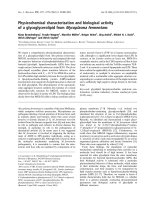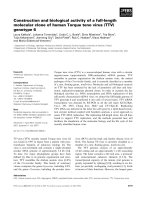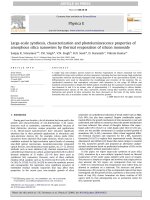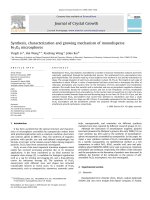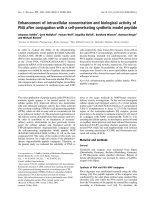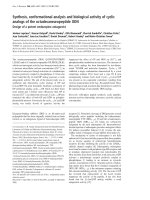Synthesis, characterization, and biological activity of coordination polymers derived from pyromellitic dianhydride
Bạn đang xem bản rút gọn của tài liệu. Xem và tải ngay bản đầy đủ của tài liệu tại đây (18.25 MB, 9 trang )
Turkish Journal of Chemistry
/>
Research Article
Turk J Chem
(2013) 37: 978 – 986
ă ITAK
c TUB
doi:10.3906/kim-1206-22
Synthesis, characterization, and biological activity of coordination polymers
derived from pyromellitic dianhydride
Yogesh Shantilal PATEL,1 Ritu Bharat DIXIT,2 Hasmukh Shanubhai PATEL1,∗
1
Department of Chemistry, Sardar Patel University, Vallabh Vidyanagar, Gujarat, India
2
Ashok & Rita Patel Institute of Integrated Studies and Research in Biotechnology and Allied Sciences,
New Vallabh Vidyanagar, Gujarat, India
Received: 12.06.2012
•
Accepted: 11.06.2013
•
Published Online: 04.11.2013
•
Printed: 29.11.2013
Abstract: A new ligand, 2,5-bis(furan-2-ylmethylcarbamoyl)terephthalic acid (BFMTA), was synthesized using 1,2,4,5benzenetetracarboxylic dianhydride (pyromellitic dianhydride-PMDA) with furan-2-ylmethanamine (2-furfurylamine).
New coordination polymers of the ligand (BFMTA) were also prepared using transition metal ions Mn(II), Fe(II),
Co(II), Ni(II), Cu(II), and Zn(II) metal salts. The coordination polymers and ligand were characterized by physicochemical characteristics, magnetic susceptibilities, spectroscopic investigations, and thermogravimetry. Antimicrobial
activity was tested using the agar-plate method against various strains of bacteria and spores of fungi. The results
showed significantly higher antimicrobial activity of coordination polymers compared to the ligand.
Key words: Coordination polymer, spectral studies, thermogravimetric analysis (TGA), biological activity
1. Introduction
The metal–organic framework (MOF) architecture has witnessed a tremendous growth because of its intriguing
structures and potential properties. Much research is being devoted to the preparation of a polymeric chain
by the formation of metallic chelates. Some success has been achieved in the preparation of coordination
polymers from bi-functional ligands. MOFs derived from bisamic acid have received less attention, apart from
bisamic acid based on maleic anhydride, 1 and amic acid based on phthalic anhydride. 2−4 More particularly,
multicarboxylate material shows good building blocks in the design of MOFs with desired topologies owing to
their rich coordination modes. Therefore, the dianhydride of 1,2,4,5-benzenetetracarboxylic acid (pyromellitic
dianhydride) has been selected for further work. It is also used extensively as an important monomer in the
preparation of a variety of polymers. Moreover, it is useful in the preparation of high performance coatings that
have been widely employed in many fields because of its excellent thermal and oxidative stability and excellent
mechanical properties. 5−7 This may offer the compound both metal gripping potentiality and good biological
efficacy due to anhydride moiety. The MOF based on bisamic acid of pyromellitic dianhydride has not attracted
any attention. Hence, the initial work in this direction has been reported by us recently. 8,9 This prompted us
to extend our work by using other auxiliary ligands such as 2,5-bis(furan-2-ylmethylcarbamoyl)terephthalicacid
(BFMTA). Considering the special biological activity along with its properties, we have focused our work on
this ligand by complexation using Mn(II), Fe(II), Co(II), Ni(II), Cu(II), and Zn(II) metal ions.
∗ Correspondence:
978
PATEL et al./Turk J Chem
2. Experimental
All common reagents and solvents used were of analytical grade. Alumina supported pre-coated silica gel 60
F254 thin layer chromatography (TLC) plates were purchased from E. Merck (India) Limited, Mumbai, and
were used to check the purity of compounds and to study the progress of the reaction, whereby TLC plates
were illuminated under ultraviolet light (254 nm), evaluated in I 2 vapors, and visualized by spraying with
Draggendorff’s reagent. Infrared spectra (FT-IR) were obtained from KBr pellets in the range of 4000–400
cm −1 with a PerkinElmer spectrum GX spectrophotometer (FT-IR).
1
13
H NMR and
C NMR spectra were
acquired at 400 MHz on a Bruker NMR spectrometer using DMSO-d6 (residual peak at δ ∼2.5 or ∼ 39.5
ppm, 300 K) as a solvent as well as TMS an internal reference standard. Microanalytical (C, N, H) data
were obtained using a PerkinElmer 2400 CHN elemental analyzer. The solid diffuse electronic spectra were
recorded on a Beckman DK-2A spectrophotometer with a solid reflectance attachment. MgO was employed
as a reference. Magnetic moments 10 were determined by the Gouy method with mercury tetrathiocyaneto
cobaltate(II), with [HgCo(NCS) 4 ] as calibrant (Xg = 1644 × 10 −6 cgs units at 20
◦
C), by Citizen balance
11
(at room temperature). Molar susceptibilities were corrected using Pascal’s constant. The thermogravimetric
analysis studies were carried out with a PerkinElmer thermogravimetry analyzer at a heating rate of 10 ◦ C
min −1 in the temperature range 50–700 ◦ C under nitrogen. The metal content of the coordination polymers was
determined by decomposing a weighed amount of each coordination polymer with HClO 4 , H 2 SO 4 , and HNO 3
(1:1.5:2.5) mixture followed by standard EDTA titration. 12 The number-average molecular weight (Mn) of
coordination polymers was determined by nonaqueous conductometric titration. It was carried out in pyridine
solution against standard sodium methoxide in pyridine solution as titrant. The number-average molecular
weight of each sample was calculated as reported in the literature 13 and the results are shown in Table 1. The
melting point was determined by the standard open capillary method.
Table 1. Physicochemical parameters of the ligand and its coordination polymers.
Empirical formula of
compound
BFMTA
C20 H16 N2 O8
[Mn(BFMTA)H2 O)2 ]n
C20 H19 N2 O10 Mn
[Fe(BFMTA)(H2 O)2 ]n
C20 H19 N2 O10 Fe
[Co(BFMTA)(H2 O)2 ]n
C20 H19 N2 O10 Co
[Ni(BFMTA)(H2 O)2 ]n
C20 H19 N2 O10 Ni
[Cu(BFMTA)(H2 O)2 ]n
C20 H19 N2 O10 Cu
[Zn(BFMTA)(H2 O)2 ]n
C20 H19 N2 O10 Zn
a
Empirical
weight (g)
Color
Yield
%
M.P.a
(◦ C)
412.35
light
yellow
75
260
502.31
white
45
450
52
439
49
437
57
464
503.22
506.31
506.07
light
brown
light
pink
light
green
510.92
green
65
474
512.78
white
40
453
Elemental analysis
C
H
58.25
3.91
(58.02) (3.76)
47.82
3.81
(47.58) (3.69)
47.74
3.81
(47.49) (3.68)
47.44
3.78
(47.28) (3.61)
47.47
3.78
(47.21) (3.61)
47.02
3.75
(46.87) (3.51)
46.85
3.73
(46.69) (3.62)
calc. (found %)
N
M
6.79
—
(6.52)
5.58
10.94
(5.41)
(10.71)
5.57
11.10
(5.21)
(10.88)
5.53
11.64
(5.39)
(11.48)
5.54
11.60
(5.42)
(11.39)
5.48
12.44
(5.31)
(12.36)
5.46
12.76
(5.33)
(12.59)
µef f
B.M.
Mn
DP
—
—
—
5.34
2975
6
5.13
2976
6
4.65
2512
5
2.89
2489
5
2.67
3039
6
D
2511
5
The melting points were checked by standard open capillary method and are uncorrected, µef f B.M.: Magnetic moment
M n Number average molecular weights, DP: Degree of polymerization, D: Diamagnetic.
2.1. Preparation of 2,5-bis(furan-2-ylmethylcarbamoyl)terephthalicacid (BFMTA)
Adding dropwise a solution of furan-2-ylmethanamine (19.43 g, 0.2 mol) to a stirred solution of pyromellitic
dianhydride (21.813 g, 0.1 mol) and keeping the temperature of the medium close to 0–5 ◦ C for 1 h (Scheme),
979
PATEL et al./Turk J Chem
the solution obtained was poured into ice water in which the reaction product precipitated. The final white
precipitates were filtered, washed, and purified by column chromatography. Yield was 65%; M. Wt. 412.35 g;
Decomposition temp.: 250–260 ◦ C (uncorrected); Elemental Analysis Calculated for C 20 H 16 N 2 O 8 : C 58.25,
H 3.91, N 6.79% Found: C 57.87, H 3.75, N 6.58%; 1 H NMR (DMSO- d6 , δ ppm): 10.93 (s, 2H, -COOH), 8.90
(t, J = 5.2 Hz, 2H, -NH-CO-), 8.12 (s, 2H, Ar.H), 7.49–7.93 (m, 6H, Ar.H), 4.32 (d, J = 5.2 Hz, 4H, -CH 2 -);
DEPT-135 (DMSO-d6 , δ ppm): 42.24, 117.78, 119.24, 123.46, 126.10, 129.33; EI MS m/z: 413.23 [M + H] + .
O
O
O
O
+
2
O
O
O
pyromellitic
dianhydride
NH2
furan-2-yl
methanamine
0-5 °C
O
O
O
OH
NH
NH
HO
O
O
O
2,5-bis((furan-2-ylmethyl)carbamoyl)terephthalic acid
(BFMTA)
metal ion
O
H2O
O
H2O
O
O
NH
M
M
NH
O
H2O
O
O
O
H2O
n
Co-ordination polymers
M=Mn(II),Fe(II),Co(II),Ni(II),Cu(II),Zn(II)
Scheme. Synthetic route for the coordination polymers.
2.2. Preparation of coordination polymers
All the coordination polymers were synthesized by using equimolar amounts of ligand and metal salt. A warm
and clear solution of BFMTA (4.1235 g, 0.01 mol) in dimethylsulfoxide was neutralized by adding dropwise
0.1 M sodium hydroxide solution. When a pasty mass was observed, it was diluted with water to make the
solution clear. To the above solution was added a solution of copper acetate (1.997 g, 0.01 mol) with constant
stirring and the pH of the reaction mixture was adjusted to 4–5. The BFMTA-Cu 2+ coordination polymer thus
separated out in the form of a suspension was digested on a water bath for 1 h, filtered, washed, and dried in
air at room temperature. The BFMTA-Cu 2+ polymer is insoluble in common organic solvents like methanol,
980
PATEL et al./Turk J Chem
ethanol, chloroform, acetone, and benzene. A similar procedure was followed to prepare other coordination
polymers such as BFMTA-Mn 2+ , BFMTA-Fe 2+ , BFMTA-Co 2+ , BFMTA-Ni 2+ , and BFMTA-Zn 2+ by using
their respective salts and maintaining pH accordingly. The synthetic route is shown in the Scheme.
3. Results and discussion
3.1. Characterization of 2,5-bis(furan-2-ylmethylcarbamoyl)terephthalicacid (BFMTA)
To the best of our knowledge, BFMTA has not been reported previously. The characterization of the reaction
product provided the first unambiguous proof of the successful synthesis of BFMTA. The FTIR spectrum of
BFMTA showed the most relevant peaks of the furan ring and 1,2,4,5-tetra substituted benzene ring, other
than typical absorptions arising from the band at 3528 cm −1 and 1711 cm −1 for carboxylic acid and 3254
cm −1 and 1680 cm −1 for the O =C-NH group. 14 In the 1 H NMR spectroscopy (Figure 1), the signals in the
range of 7.49–7.93 ppm were ascribed to the protons of the aromatic rings. The singlet at 10.93 ppm was
ascribed to the protons of the carboxylic -OH group and the triplet at 8.90 ppm was attributed to the -NH
proton of the amide group, which was further confirmed by DEPT-135 values. In the DEPT-135 spectrum
of BFMTA (Figure 2), the inverted peak at 42.24 ppm indicated a methylene bridge between the amide and
furan ring. The peaks at 126.10 ppm and 129.33 ppm indicated the carbonyl carbon of amide and carboxylic
functionality. Peaks of substituted carbon of aromatic rings were not observed while the peaks of unsubstituted
aromatic carbon were observed at 117.78, 119.24, and 123.46 in the DEPT-135 spectra. The monomer BFMTA
started to lose weight because of thermal degradation. The thermogram of the product BFMTA (Figure 3)
indicated that the degradation occurred into 2 steps. The first stage of degradation, from 180 to 300 ◦ C,
might be attributed to decarboxylation of the product BFMTA. The value of wt. loss 20.91% is consistent
with the theoretical value 21.34%. The second major stage, at about 300 to 700 ◦ C, was attributed to the
monomer decomposition/pyrolysis. The 3% to 4% char residue remained at 700 ◦ C. The expected structure
was thus clearly verified by the spectroscopic and thermal analysis, which indicated moreover the absence of
any detectable impurity, particularly of the 2 reagents used to prepare BFMTA.
3.2. Characterization of coordination polymers
Elemental analysis (Table 1) of the coordination polymers is in good agreement with the proposed structures.
All the coordination polymers exhibited 1:1 metal to ligand stoichiometry. The structures of the coordination
polymers are consistent with the FTIR, electronic spectra, and TGA. The geometry of the central metal ion
was confirmed by electronic spectra and magnetic susceptibility measurements. The degrees of polymerization
(DP) for all the coordination polymers are in the range of 5 to 6. All the data provide good evidence that the
chelates are polymeric in nature. The suggested structure of the coordination polymers is shown in the Scheme.
A comparison of the IR spectra (Table 2) of the ligand and its metal (II) coordinated polymers showed
some significant characteristic differences. Considerable differences to be expected were the band at about 3530
cm −1 for carboxylic acid in ligand that was virtually absent from the spectra of polymers and the presence of a
more broadened band in the region near 3000 cm −1 for the coordinated polymers. As the oxygen atom of the OH
group of the ligand forms a coordination bond with the metal ions, the broadening of this band may be attributed
to the presence of coordinated water molecules. 15 The asymmetric and symmetric stretching frequencies of the
carboxylate ion in the polymers were shifted to lower frequencies. The C–O also registered a significant shift
to lower frequency, indicating the participation of metal through carboxylate oxygen. 16 Vibrational bands for
O= C–NH (amide carbonyl linkage) shifted to lower frequencies, indicating the coordination of amide nitrogen
981
PATEL et al./Turk J Chem
Figure 1. NMR of 2,5-bis(furan-2-ylmethylcarbamoyl)terephthalic acid (BFMTA).
Figure 2. DEPT of 2,5-bis(furan-2-ylmethylcarbamoyl)terephthalic acid (BFMTA).
to metal ion, and this can be explained by the donation of electrons from nitrogen to metal atom. 17 The presence
of a sharp band in the region of 525–535 cm −1 can be assigned to ν (M-N), 18 which indicated the involvement
of nitrogen in coordination. A medium intensity band for ν (M-O) 19 was observed at 625–640 cm −1 due to
M-O coordination. These features confirmed the proposed structure of coordination polymers.
982
—
—
—
—
[Mn(BFMTA)H2 O)2 ]n
[Fe(BFMTA)(H2 O)2 ]n
[Co(BFMTA)(H2 O)2 ]n
[Ni(BFMTA)(H2 O)2 ]n
[Zn(BFMTA)(H2 O)2 ]n
—
—
3528
BFMTA
[Cu(BFMTA)(H2 O)2 ]n
C=O-OH
Compound
3237
2980
3004
2991
3231
3231
3238
2980
2997
2989
—
-OH
3239
3228
3235
3254
O=C-NH
1698
1696
1697
1693
1690
1692
1711
-C=O
1666
1667
1661
1665
1671
1663
1680
O=C-NH
1449
1452
1453
1448
1450
1451
1465
COO−
1027
1025
1022
1021
1019
1021
1039
C-O
639
625
633
640
627
632
—
M-O
527
536
529
528
535
530
—
M-N
Electronic spectral data
cm− 1
Transitions
—
—
16,486
6A1g →4T 1g (4G),
17,710
6A1g →4T 2g (4G)
23,179
6A1g → 4A1g , 4Eg
19,038
5T 2g (F)→3Eg
36,022
5T 2g (F)→3T 1g
9830
4T 1g (F)→4T 2g (F)
15,520
4T 1g (F)→4A2g (F)
22,941
4T 1g (F)→4T 1g (P)
9891
3A2g →3T 2g
15,584
3A2g →3T 1g (F)
22,978
3A2g →3T 1g (P)
15,922
2T 2g →2Eg
22,757
charge transfer
—
—
Table 2. FTIR and electronic spectral data of the ligand and its coordination polymers (in cm − 1 ) .
PATEL et al./Turk J Chem
983
PATEL et al./Turk J Chem
The information regarding geometry of the coordination polymers was obtained from their electronic
spectral data and magnetic moment values. The diffuse electronic spectrum of the [Cu(BFMTA)(H 2 O) 2 ] n
shows 2 broad bands around 15,922 cm −1 and 22,757 cm −1 due to the
2
T 2g →2 E g transition; the second
may be due to charge transfer. This suggests a distorted octahedral structure for the [Cu(BFMTA)(H 2 O) 2 ] n
polymer. The [Ni(BFMTA)(H 2 O) 2 ] n coordination polymer shows 2 absorption bands at 15,584 cm −1 , 22,978
cm −1 , and 9891 cm −1 due to
3
A 2g →3 T 1g (F),
3
A 2g →3 T 1g (P), and
3
A 2g →3 T 2g respectively. The
[Co(BFMTA)(H 2 O) 2 ] n polymer shows 2 absorption bands at 22,941 cm −1 , 15,520 cm −1 , and 9830 cm −1
corresponding to
4
T 1g (F) →4 T 1g (P),
4
T 1g (F) →4 A 2g (F), and
4
T 1g (F) →4 T 2g (F) transitions, respectively,
indicating an octahedral configuration for the [Ni(BFMTA)(H 2 O) 2 ] n and [Co(BFMTA)(H 2 O) 2 ] n polymers. 20
The spectrum of [Fe(BFMTA) (H 2 O) 2 ] n shows bands at 36,022 cm −1 and 19,038 cm −1 assigned to the
transitions
5
T 2g (F) →3 T 1g and
5
T 2g (F) →3 E g , suggesting an octahedral configuration. The spectrum of
[Mn(BFMTA)(H 2 O) 2 ] n shows weak bands at 16,486 cm −1 , 17,710 cm −1 , and 23,179 cm −1 assigned to
the transitions
6
A 1g →4 T 1g (4G),
6
A 1g →4 T 2g (4G), and
6
A 1g →4 A 1g , 4 E g respectively, suggesting an
octahedral structure for the [Mn(BFMTA)(H 2 O) 2 ] n polymer. 21 The spectrum of the [Zn(BFMTA)(H 2 O) 2 ] n
polymer is not well interpreted, but its µef f value shows that it is diamagnetic as expected. Magnetic moments
µef f of coordination polymers reveal that all the polymers except Zn(II) metal ion polymer are paramagnetic
while Zn(II) metal ion polymer is diamagnetic.
The thermal behavior was investigated by PerkinElmer TGA analyzer at a heating rate of 10 ◦ C min −1
in the temperature range 50–700 ◦ C under nitrogen, which provides much information about the coordination
compounds. In all the coordination polymers, decomposition occurred in 2 steps (Figure 3). The first step,
between 100 and 200 ◦ C, might be attributed to mass loss corresponding to water molecules. The weight loss
indicated that 2 water molecules were coordinated to the metal ion. The second step, between 200 and 700
◦
C with the inflation at 350 ◦ C, exhibits a mass loss corresponding to decomposition of metal from the ligand
part in the polymer. The weight loss observed in the range of 11%–13% is consistent with metal degradation.
The major weight loss of the coordination polymers was noticeable beyond 400 ◦ C. The rate of degradation
became maximal at a temperature between 400 and 600 ◦ C. This might be due to accelerating by metal oxide
that formed in situ. Each polymer lost about 80% of its weight when heated up to 700 ◦ C. On the basis of
the relative decomposition (% weight loss) and the nature of thermogram, the coordination polymers might be
arranged in order of their increasing stability as follows: Cu < Fe < Ni < Co < Zn < Mn.
3.3. Biological activity
Antibacterial activity of BFMTA and its coordination polymers (Table 3) was tested against gram-positive
bacteria (Bacillus subtilis and Staphylococcus aureus) and gram-negative bacteria (E. coli and Salmonella
typhi ) at a concentration of 50 µ g/mL by agar cup plate method. A DMSO system was used as control in this
method. The area of inhibition was measured in millimeters. The fungicidal activity of all the compounds was
studied at 1000 ppm concentration in vitro. The plant pathogenic organisms used were Penicillium expansum,
Botrydepladia thiobromine, Nigrospora sp., and Trichothesium sp. The antifungal activity of BFMTA and its
coordination polymers was measured on each of these plant pathogenic strains on a potato dextrose agar (PDA)
medium. Such a PDA medium contains potato 200 g, dextrose 20 g, agar 20 g, and water 1 L. Five-day-old
cultures were used. The compounds to be tested were suspended (1000 ppm) in a PDA medium and autoclaved
at 120 ◦ C for 15 min at 15 atm pressure. These media were poured into sterile petri plates and the organisms
984
PATEL et al./Turk J Chem
were inoculated after cooling the petri plates. The percentage inhibition for fungi was calculated after 5 days
using the formula given below:
Percentage of inhibition = 100 (X – Y) / X
where X = area of colony in control plate
Y = area of colony in test plate
110
BFMTA
[Mn(BFMTA)H2O)2]n
[Fe(BFMTA)H2O)2]n
[Co(BFMTA)(H2O)2]n
[Ni(BFMTA)(H2O)2]n
[Cu(BFMTA)(H2O)2]n
[Zn(BFMTA)(H2O)2]n
100
90
80
% Weight loss
70
60
50
40
30
20
10
0
100
200
300
400
500
Temperature
600
700
Figure 3. Thermogram of BFMTA and its coordination polymers.
Table 3. Antibacterial and antifungal activity of the ligand and its polymers.
Compound
BFMTA
[Mn(BFMTA)(H2 O)2 ]n
[Fe(BFMTA)(H2 O)2 ]n
[Co(BFMTA)(H2 O)2 ]n
[Ni(BFMTA)(H2 O)2 ]n
[Cu(BFMTA)(H2 O)2 ]n
[Zn(BFMTA)(H2 O)2 ]n
Ciprofloxacin
Antibacterial activity
Zone of inhibition
Gram +ve Gram –ve
BS SA
ST EC
22
20
21
23
27
30
27
30
32
33
35
35
27
25
26
30
29
27
28
29
34
33
36
39
32
31
30
31
43
42
45
47
Antifungal activity
Zone of inhibition
PE
BT
NS
TS
26
31
37
32
25
39
30
46
22
26
30
25
26
32
28
39
23
30
34
28
28
36
28
48
20
25
32
28
25
35
24
41
BS: Bacillus subtilis, SA: Staphylococcus aureus, ST: Salmonella typhi, EC: Escherichia coli,
PE: Penicillium expansum, BT: Botrydepladia thiobromine, NS: Nigrospora sp., TS : Trichothesium sp.
The levels of antibacterial and antifungal activity were compared with those of the standard drug
ciprofloxacin. As compared to ciprofloxacin, the compounds were less active. The ligand was found biologically
active, and its polychelates showed significantly enhanced biological activity compared to the ligand. Among
the coordination polymers, Fe(II) and Cu(II) coordination polymers showed better activity against all grampositive and gram-negative bacteria. They also showed better activity against the plant pathogenic strain. This
might be due to the additive biological effect of parent molecule and/or the metal chelating properties of Fe(II)
and Cu(II).
985
PATEL et al./Turk J Chem
4. Conclusions
A new ligand and its coordination polymers were prepared in good amount of yield and were duly characterized.
In the coordination polymers the ligand coordinates with 1 central metal atom at 4 coordination sites along
with 2 water molecules. The structures of the ligand and its coordination polymers are consistent with the
elemental, spectral, and thermal analyses. The geometry of the central metal ion was confirmed by electronic
spectra and magnetic susceptibility measurements. All the data provide good evidence that the chelates are
polymeric in nature. These polymers do not melt up to 400 ◦ C. The polymers have moderate thermal stability
and show good biological activity.
Acknowledgments
One of the authors, Yogesh S. Patel, is greatly thankful to the UGC for sanctioning his Teacher Fellowship
under the scheme of the Faculty Improvement Programme for the research work.
References
1. Dave, P. N.; Patel, N. N. Mater. Sci. Appl. 2011, 2, 771–776.
2. Tamaki, R.; Choi, J.; Laine, R. M. Chem. Mater. 2003, 15, 793–797.
3. Ueda, M.; Nakayama, T. Macromolecules 1996, 29, 6427–6431.
4. Yan, L.; Park, C.; Ounaies, Z.; Irene, E. A. Polymer. 2006, 47, 2822–2829.
5. Ramkumar, S. G.; Ramakrishnan, S. J. Chem. Sci. 2008, 120, 187–194.
6. Masahiro, T.; Takahiro, H.; Hiroyuki, O. Tetrahedron Lett. 2007, 48, 1553–1557.
7. Matsuura, T.; Hasuda, Y.; Nishi, S.; Yamada, N. Macromolecules 1991, 24, 5001–5005.
8. Patel, Y. S.; Patel, H. S.; Srinivasulu, B. Int. J. Plast. Technol. 2012, 16, 117–124.
9. Patel, Y. S.; Patel, H. S. Elixir Appl. Chem. 2012, 44, 7238–7242.
10. Vanparia, S. F.; Patel, T. S.; Sojitra, N. A.; Jagani, C. L.; Dixit, B. C.; Patel, P. S.; Dixit, R. B. Acta Chim. Slov.
2010, 57, 660–667.
11. Vogel, A. I. A Textbook of Quantitative Inorganic Analysis, 3rd Ed., Longman: London, p.433, 1961.
12. Jeffery, G. H.; Bassett, J.; Mentham, J.; Denney, R.C. Vogel’s Textbook of Quantitative Inorganic Analysis, fifth
ed. Longman: Harlow, 1989.
13. Chatterjee, S. K.; Gupta, N. D. J. Polym. Sci., Polym. Chem. Ed. 1973, 11, 1261–1270.
14. Silverstein, R. M.; Webste, F. X. Spectrometric Identification of Organic Compounds. 6th Ed.; John Wiley & Sons,
Inc: New York, 2004.
15. Panchal, P. K.; Pansuriya, P. B.; Patel, M. N. J. Enz. Inhib. Med. Chem. 2006, 21, 453–458.
16. Nakamoto, K. Infrared and Raman Spectra of Inorganic and Coordination Compounds, 3rd Ed.; Wiley: New York,
1978.
17. Lever, A. B. P. Inorganic Electronic Spectroscopy; 2nd Ed; Elsevier: Amsterdam, 1984.
18. Malik, A.; Parveen, S.; Ahmad, T. Bioinorg. Chem. Appl. 2012, 10, 1155–1162.
19. Soliman, E. M.; El-Shabasy, M. J. Mater. Sci. 1994, 29, 4505–4509.
20. Lewis, J.; Wilkins, R. S. Modern Coordination Chemistry. Interscience: New York, p. 290, 1960.
21. Papplardo, R. J. Chem. Phys. 1960, 33, 613–614.
986


